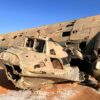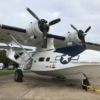As always, there is news to report from around the world although our column is fairly short this time. Do contact the Editor if you have any news to report. Our Catalina Society website hosts probably the most accurate and up-to-date Catalina Survivors listing to be found anywhere. A word of explanation – to be consistent, the listing, and this magazine feature, describes Catalinas by their original designations when built. Click here to view the list.
Since December 2005, the Pima Air & Space Museum at Tucson, Arizona has been home to the derelict hulk of a former Royal Canadian Air Force Canso A, serial 9839 or, possibly, 9829. Way back in 1950, it was one of four surplus examples acquired by Brighton, Ontario-based George Ventress who moved them to his farm. One was converted to a cruiser for use on local waterways but the other three languished as hulls only on his land. Over the years, the identities of two of them – 9829 and 9839 – became mixed but it is known that one, thought to be 9839, was acquired around 1989 by one Derrick Arnold on behalf of Austin Wadsworth of the 1941 Historical Aircraft Group Museum. It was moved to Geneseo in New York State and stored in a barn there until ownership passed to the Pima Air & Space Museum in 2005. It left Geneseo for open storage with the museum in Tucson on December 14th, 2005. Left in a storage compound with several other Catalina hulks, its future seemed uncertain but at the beginning of January this year, word went out that it was available for anyone interested, failing which it would be scrapped. Within a short space of time, the Eugene, Oregon-based operators of airworthy Canso A N9767 were on the case and it was agreed that it would become the new owner. More news in our next edition!….
It is sometime now since I reported on the two PBY-6As N324FA and N7179Y that are being worked on at Richard I Bong Airport, Superior, Wisconsin. Both aircraft were built for the US Navy and would have progressed down the Consolidated production line in New Orleans at the same time as their manufacturers serial numbers were only five apart. Here is their recent background: ‘The Southern Minnesota Wing was formed as a detachment of what was then the Confederate Air Force in 2000 for the purpose of maintaining the PBY-6A Catalina N324FA. It had been purchased to replace another PBY-6A N7179Y that had been virtually destroyed when it overturned in a wind-storm at Fleming Field, St Paul, Minnesota at the end of May 1998. Finance came from a fund raiser and N7179Y’s insurance money. The insurance company demanded that N324FA be kept in a hangar. As the Southern Minnesota Wing’s hangar was already full, it found an abandoned 1948 USAF hangar at the Duluth International Airport that had been decommissioned in 1982 and left to the elements. The arrival of N324FA was the catalyst for the formation of a unit as a detachment of the ‘Wing and work began to rehabilitate the hangar. The Wing’ paid the bills and maintained assignment of the aircraft.
The unit briefly became a CAF squadron but then returned to detachment status. In due course, for various reasons, the members lost interest and the unit was shut down although not fully disbanded. N324FA was put up for sale by the registered owner American Airpower Heritage Flying Museum Inc on behalf of the CAF (which on, January 1st 2002, had been renamed the Commemorative Air Force). Prior to this decision, it had been flown to CAF HQ at Midland, Texas where it was inspected and deemed to be suffering from considerable corrosion of the hull. It went back to Duluth and after further inspection of both it and the damaged N7179Y the decision was taken to delay the sale of N324FA and concentrate on restoring N7179Y, now colloquially known as the ‘Blue PBY’ based on its US Navy colour scheme.
A meeting of the Minnesota Wing took place and in March 2008 the creation of the Lake Superior Squadron was authorised by the CAF with both N324FA and N7179Y coming under its remit. The latter aircraft had been moved to Duluth during 2006 and concerted efforts to restore it began using the wing from N324FA. In August 2009 with the cooperation of aircraft manufacturer Cirrus Design (now Cirrus Aircraft), the wing and engines from N324FA were mated to the hull superstructure of N7179Y and restoration work on the flight controls, trailing edges and the hull area fore and aft of the ‘step’ proceeded.
An ongoing problem was the condition of the Duluth hangar which, amongst other defects, was prone to leakage. These issues culminated in 2016 and 2017 when strong winds and excessive rains respectively made use of the hangar impracticable. A new-build was beyond the group’s resources and them in November 2017 the hangar was declared unsafe by the airport authority and an eviction notice was served on the Lake Superior Squadron. In July 2018, both Catalinas together with other aircraft in the collection were moved to a hangar at the Richard I Bong Airport where work continues on the Blue PBY. At the time of writing, the latest update from the Lake Superior Squadron revealed that conservation work on the forward, starboard hull is now 99% complete with just a little work to be done on the jacking point. Some extrusion material is required for the ceiling of the navigator’s area, about 200 ft being required.
Meanwhile, no work was planned for this winter on N324FA. Because of her former firefighting bright red colour scheme, she was known as the ‘Red PBY’ but more recently she has been painted black to resemble a wartime ‘Black Cat’ so is now known as the ‘Black Cat PBY’. Eventually she will be restored as a static exhibit but in the meantime is parked outside and visible to passersby. Thanks to Jergen Fuhr of the Commemorative Air Force for some of the information included in this piece.
The original version of this article appeared in The Catalina News, Issue 95. The hard copy magazine is sent to subscribing members of The Catalina Society – see the membership tab on this website.

















